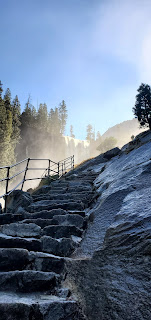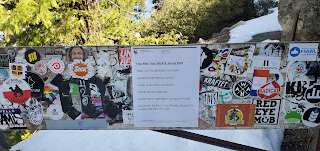Little Yosemite Valley
 |
| Nevada Falls |
Hello ProRangers and park people! This week I patrolled the Mist Trail and hiked to Little Yosemite Valley (LYV). During my patrol, I looked for fallen trees and other trail obstructions to determine when the trail can be reopened for the season. I also contacted seven individuals during my patrol who violated the existing trail closure and provided information and warnings to comply with trail closures. To wrap up the week, I participated in a few COVID-19 scenarios conducted by the Valley EMS crew. These scenarios help test out current protocols and provide insight into ways we can improve our response for future calls.
Although I have previously hiked the Mist Trail, this weekends patrol was even more spectacular as both Vernal and Nevada falls were very active after recent snowfall and storms. The additional water falling from the falls created a fine mist that coated rocks and made for a stunning rainbow. During my patrol, I familiarized myself with the trail and identified common areas for search and rescues.
 |
The Trail up the Nevada Falls is often slick with mist and can create hazardous conditions. This section is referred to as the "wet steps". |
 |
| Following the "wet steps", the "dry steps" provide another landmark for future SAR's |
After hiking up the "wet" and "dry" steps, visitors arrive at Emerald pool atop Vernal Falls. Although this pool looks calm and inviting for swimming, the current is very strong and often catches people off guard leading to significant injury and even death. For this reason, swimming in Emerald Pool is prohibited.
 |
| Emerald Pool atop Vernal Falls |
After reaching Vernal Falls I hiked to Nevada Falls, a 594-foot high waterfall fed by the Merced River. During this time, I encountered a number of hikers who violated the Mist Trail closure in order to reach Nevada Falls. I educated each hiker on the public use limit and informed them they would need to hike back to the valley using a safer route. While everyone wants the opportunity to hike, doing so on a closed trail poses a number of risks. On the Mist Trail, rockfalls, ice and snow can often lead to disaster. For these reasons, the trail is often closed until all snow and ice have melted. Furthermore, due to the risk of COVID-19 exposure, there is limited EMS/SAR operations available in the park. Combined, these factors have led to a number of trail closures in Yosemite Valley. Ensuring compliance with trail closures is an important task and something I look forward to doing more as the season progresses.
After reaching the top of Nevada falls, I took the John Muir Trail (JMT) junction to Little Yosemite Valley (LYV). This trail is popular during the summer when hundreds of hikers make their way to the Half Dome cables. During the summer season, I will be stationed at the LYV ranger station checking camping/hiking permits for the 300 people allowed to summit Half Dome per day. Given the amount of time I will be spending at LYV during the summer, this weeks patrol provided a great opportunity to get acquainted with where I will be staying. While hiking the additional mile from the JMT junction to LYV, I took note of multiple fallen trees and debris that will be cleared by the trail crew.
 |
| Fallen trees across the trail |
 |
| Entering Little Yosemite Valley |
After making my way up to LYV, I checked the Ranger's station for any environmental or animal damage. Luckily, the Ranger's station was free from damage. In the coming weeks, I will return to LYV to set up solar panels, a water tank, and tents for those who will be checking permits and maintaining the trail system.
 |
A portion of the LYV Ranger's Station
|
 |
| Bathroom and campsite at LYV |
In addition to patrolling the Mist Trail, I also participated in a number of EMS COVID-19 scenarios this week. These scenarios test our preparedness for a possible COVID-19 case in the park and bring to light areas for improvement. During these scenarios, I assumed the role of a patient as well as a dispatcher. After countless scenarios, I am confident that we are well prepared to handle a possible or confirmed case of COVID-19 in the park. Nevertheless, practice makes perfect!
 |
| COVID-19 Scenario |
I look forward to sharing my experiences with you again next week.
Until next time,
ProRanger Caruso


























